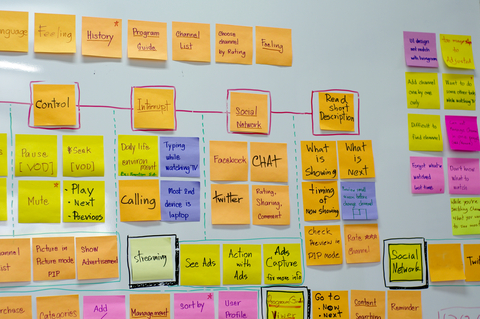 Brainstorming is the key to creativity, but why do some people dread brainstorming sessions?
Brainstorming is the key to creativity, but why do some people dread brainstorming sessions?
Every few months I come across an article that claims brainstorming is a pointless, waste of time. But if you read the articles, they are really saying that brainstorming done poorly is bad and most do it poorly in big groups, out loud.
Bad brainstorming scenario:
Your project hit a roadblock and you need a workaround. You schedule a “Brainstorming Session.” On the day of the meeting, the 20-person team gathers together, some on the phone and some in a conference room. You stand up, restate the problem and ask the team for ideas.
Outcome #1: Three or four of the 20 attendees offer solution ideas. You dutifully write them on the board. Then, you ask the group to choose one of the ideas. The conversation circles round and round with four to five people actively participating–the others are multitasking or having side conversations. No one is satisfied with the solutions. The meeting runs long. People start to leave. The meeting ends without a consensus and new issues and new action items.
Outcome #2: One attendee proposes an idea. Three people ask clarifying questions. All twenty people agree with the approach and the meeting ends in ten minutes. Two weeks later, you realize the solution did not clear the roadblock and, in fact, it created a few new problems.
Avoid bad brainstorming
A Wall Street Journal article used the term “coblaberation” to describe bad brainstorming. To avoid the “blab”–endless unproductive discussion–you need to keep your brainstorming groups small. I’ve heard others say “greater than eight, no collaborate,” or you could use the “two pizza rule”: Amazon’s Jeff Bezos says a meeting is too large if it takes more than two pizzas to feed everyone.
Small groups minimize groupthink (attendees latch on to one popular idea and keep their questions or opinions to themselves). There are so many reasons groupthink takes over–apathy, busy people who want the meeting to end, or fear of opposing the group.
Reduce the blab and inspire creativity during your 2014 brainstorming sessions!
- Be sneaky! Don’t call your meeting a brainstorming session. Don’t say,”Let’s brainstorm a list of ideas!” Instead, look for opportunities to gather ideas in every meeting. Gather information by asking questions: how might we…?, what would that look like?, how could you modify that idea? what if we can’t do that?
- Fill your toolbox. There are hundreds of active, engaging and effective ways to brainstorm. Check out MindTools, Innovation Games and Stanford’s Design School.
- Engage ALL participants. Use techniques that require input from everyone. Allow each person to brainstorm independently. Participants can send their ideas to a facilitator before the meeting or let each person scribe ideas on post-its during the meeting.
- Focus on quantity, not quality. No editing or judgment or analysis during brainstorming. Set a short timeframe, maybe 15 minutes, to generate 50 ideas. (You can sort, group, analyze and evaluate later.)
